Biosecurity and Invasive Species
VerifiedAdded on 2020/02/05
|11
|3463
|144
AI Summary
This assignment delves into the topic of biosecurity and the threat posed by invasive plant species, specifically *Parkinsonia aculeata*. It analyzes the potential impacts of this invasive species and examines various biosecurity strategies employed to mitigate its spread. The assignment draws upon scientific literature and official guidelines from Australian authorities like PIRSA and the Department of Environment.
Contribute Materials
Your contribution can guide someone’s learning journey. Share your
documents today.

Plant bio security
1
1
Secure Best Marks with AI Grader
Need help grading? Try our AI Grader for instant feedback on your assignments.

TABLE OF CONTENTS
INTRODUCTION ..........................................................................................................................3
MAIN BODY...................................................................................................................................3
CONCLUSION ...............................................................................................................................9
REFERENCES..............................................................................................................................10
2
INTRODUCTION ..........................................................................................................................3
MAIN BODY...................................................................................................................................3
CONCLUSION ...............................................................................................................................9
REFERENCES..............................................................................................................................10
2

INTRODUCTION
Plant bio-security is considered as set of measures that are developed towards protecting
the crops, crops or sub groups from the emergency plant pests at national, regional as well as
individual farm levels. Biosecurity has become the main global issue. Harmful plant pests as well
as diseases have huge influence on the safety of food, trade, access to market , development of
market as well as the profitability and sustainability of the plant industries (Brasier, 2008). It has
been assessed that Australia is free from several plant and diseases that are affecting agricultural
industries in other nations. In the present report that weed that has been discussed is Parkinsonia.
It is regarded as worst weeds in Australia as a reason of its invasiness, potential for spread as
well as economic and environmental influence. It act as threat to rangelands as well as wetlands
around Australia. The study includes background about the weed. Along with this it includes the
threats that are attached with the weeds. Further it includes the manner in which it can be
managed in an effective manner.
MAIN BODY
Overview
Parkinsonia is worst weed within Australia due to the reason of invasiness, potential for
spread as well as economic and environmental influence. There are greater number of
environmental impact of Parkinsonia. Wetlands are vulnerable as parkinsonia can dam the
watercourses, results in erosion, lower watertables and can take over the vast tracts related with
flood plain. The growth of Parkinsonia can be upto 8 m. Though there is greater popularity of the
smaller plants. It can be single or multi stemmed. The smooth green stems are slender and tends
at droop and zig-zag (Chakraborty and Newton, 2011). The leaves it possess are different to the
femy leave of the three other prickle bushes. The flowers of parkinsonia are comprised of flat,
green leaf stalk upto 300 mm long and 2-3 mm wider with number of oblong leaflets that are
staggered on both the sides. The flowers of Parkinsonia are about 20mm across that possess
yellow petals and one erect orange or orange spotted petals. Seed pods are being straight with
bulges around the seeds as well as points on either ends. Parkinsonia is one of the four prickle
bushes that is considered as the weeds across the semi arid Australia. The control of this weed is
expensive however the prevention in relation to spread is more cost effective. Parkinsonia was
3
Plant bio-security is considered as set of measures that are developed towards protecting
the crops, crops or sub groups from the emergency plant pests at national, regional as well as
individual farm levels. Biosecurity has become the main global issue. Harmful plant pests as well
as diseases have huge influence on the safety of food, trade, access to market , development of
market as well as the profitability and sustainability of the plant industries (Brasier, 2008). It has
been assessed that Australia is free from several plant and diseases that are affecting agricultural
industries in other nations. In the present report that weed that has been discussed is Parkinsonia.
It is regarded as worst weeds in Australia as a reason of its invasiness, potential for spread as
well as economic and environmental influence. It act as threat to rangelands as well as wetlands
around Australia. The study includes background about the weed. Along with this it includes the
threats that are attached with the weeds. Further it includes the manner in which it can be
managed in an effective manner.
MAIN BODY
Overview
Parkinsonia is worst weed within Australia due to the reason of invasiness, potential for
spread as well as economic and environmental influence. There are greater number of
environmental impact of Parkinsonia. Wetlands are vulnerable as parkinsonia can dam the
watercourses, results in erosion, lower watertables and can take over the vast tracts related with
flood plain. The growth of Parkinsonia can be upto 8 m. Though there is greater popularity of the
smaller plants. It can be single or multi stemmed. The smooth green stems are slender and tends
at droop and zig-zag (Chakraborty and Newton, 2011). The leaves it possess are different to the
femy leave of the three other prickle bushes. The flowers of parkinsonia are comprised of flat,
green leaf stalk upto 300 mm long and 2-3 mm wider with number of oblong leaflets that are
staggered on both the sides. The flowers of Parkinsonia are about 20mm across that possess
yellow petals and one erect orange or orange spotted petals. Seed pods are being straight with
bulges around the seeds as well as points on either ends. Parkinsonia is one of the four prickle
bushes that is considered as the weeds across the semi arid Australia. The control of this weed is
expensive however the prevention in relation to spread is more cost effective. Parkinsonia was
3
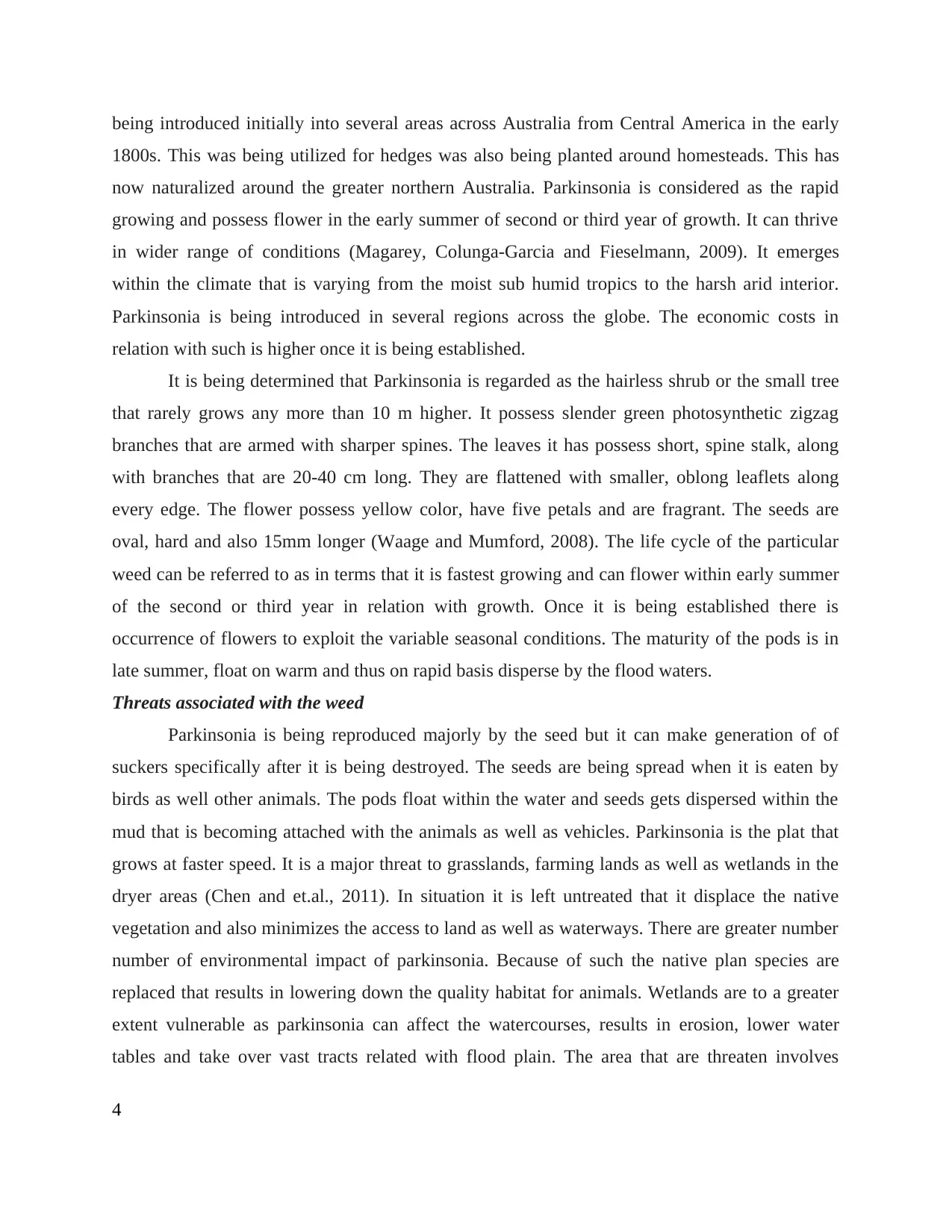
being introduced initially into several areas across Australia from Central America in the early
1800s. This was being utilized for hedges was also being planted around homesteads. This has
now naturalized around the greater northern Australia. Parkinsonia is considered as the rapid
growing and possess flower in the early summer of second or third year of growth. It can thrive
in wider range of conditions (Magarey, Colunga-Garcia and Fieselmann, 2009). It emerges
within the climate that is varying from the moist sub humid tropics to the harsh arid interior.
Parkinsonia is being introduced in several regions across the globe. The economic costs in
relation with such is higher once it is being established.
It is being determined that Parkinsonia is regarded as the hairless shrub or the small tree
that rarely grows any more than 10 m higher. It possess slender green photosynthetic zigzag
branches that are armed with sharper spines. The leaves it has possess short, spine stalk, along
with branches that are 20-40 cm long. They are flattened with smaller, oblong leaflets along
every edge. The flower possess yellow color, have five petals and are fragrant. The seeds are
oval, hard and also 15mm longer (Waage and Mumford, 2008). The life cycle of the particular
weed can be referred to as in terms that it is fastest growing and can flower within early summer
of the second or third year in relation with growth. Once it is being established there is
occurrence of flowers to exploit the variable seasonal conditions. The maturity of the pods is in
late summer, float on warm and thus on rapid basis disperse by the flood waters.
Threats associated with the weed
Parkinsonia is being reproduced majorly by the seed but it can make generation of of
suckers specifically after it is being destroyed. The seeds are being spread when it is eaten by
birds as well other animals. The pods float within the water and seeds gets dispersed within the
mud that is becoming attached with the animals as well as vehicles. Parkinsonia is the plat that
grows at faster speed. It is a major threat to grasslands, farming lands as well as wetlands in the
dryer areas (Chen and et.al., 2011). In situation it is left untreated that it displace the native
vegetation and also minimizes the access to land as well as waterways. There are greater number
number of environmental impact of parkinsonia. Because of such the native plan species are
replaced that results in lowering down the quality habitat for animals. Wetlands are to a greater
extent vulnerable as parkinsonia can affect the watercourses, results in erosion, lower water
tables and take over vast tracts related with flood plain. The area that are threaten involves
4
1800s. This was being utilized for hedges was also being planted around homesteads. This has
now naturalized around the greater northern Australia. Parkinsonia is considered as the rapid
growing and possess flower in the early summer of second or third year of growth. It can thrive
in wider range of conditions (Magarey, Colunga-Garcia and Fieselmann, 2009). It emerges
within the climate that is varying from the moist sub humid tropics to the harsh arid interior.
Parkinsonia is being introduced in several regions across the globe. The economic costs in
relation with such is higher once it is being established.
It is being determined that Parkinsonia is regarded as the hairless shrub or the small tree
that rarely grows any more than 10 m higher. It possess slender green photosynthetic zigzag
branches that are armed with sharper spines. The leaves it has possess short, spine stalk, along
with branches that are 20-40 cm long. They are flattened with smaller, oblong leaflets along
every edge. The flower possess yellow color, have five petals and are fragrant. The seeds are
oval, hard and also 15mm longer (Waage and Mumford, 2008). The life cycle of the particular
weed can be referred to as in terms that it is fastest growing and can flower within early summer
of the second or third year in relation with growth. Once it is being established there is
occurrence of flowers to exploit the variable seasonal conditions. The maturity of the pods is in
late summer, float on warm and thus on rapid basis disperse by the flood waters.
Threats associated with the weed
Parkinsonia is being reproduced majorly by the seed but it can make generation of of
suckers specifically after it is being destroyed. The seeds are being spread when it is eaten by
birds as well other animals. The pods float within the water and seeds gets dispersed within the
mud that is becoming attached with the animals as well as vehicles. Parkinsonia is the plat that
grows at faster speed. It is a major threat to grasslands, farming lands as well as wetlands in the
dryer areas (Chen and et.al., 2011). In situation it is left untreated that it displace the native
vegetation and also minimizes the access to land as well as waterways. There are greater number
number of environmental impact of parkinsonia. Because of such the native plan species are
replaced that results in lowering down the quality habitat for animals. Wetlands are to a greater
extent vulnerable as parkinsonia can affect the watercourses, results in erosion, lower water
tables and take over vast tracts related with flood plain. The area that are threaten involves
4
Paraphrase This Document
Need a fresh take? Get an instant paraphrase of this document with our AI Paraphraser
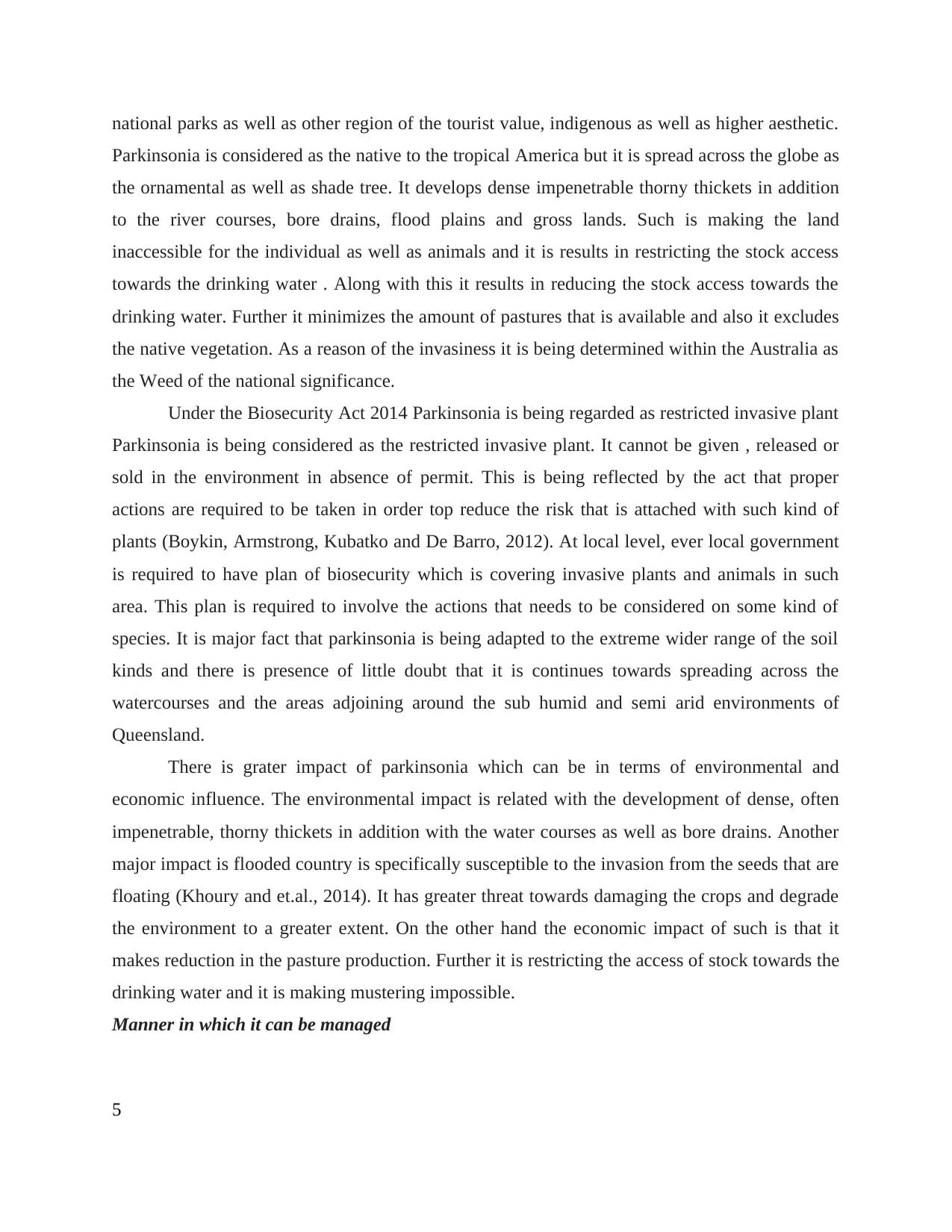
national parks as well as other region of the tourist value, indigenous as well as higher aesthetic.
Parkinsonia is considered as the native to the tropical America but it is spread across the globe as
the ornamental as well as shade tree. It develops dense impenetrable thorny thickets in addition
to the river courses, bore drains, flood plains and gross lands. Such is making the land
inaccessible for the individual as well as animals and it is results in restricting the stock access
towards the drinking water . Along with this it results in reducing the stock access towards the
drinking water. Further it minimizes the amount of pastures that is available and also it excludes
the native vegetation. As a reason of the invasiness it is being determined within the Australia as
the Weed of the national significance.
Under the Biosecurity Act 2014 Parkinsonia is being regarded as restricted invasive plant
Parkinsonia is being considered as the restricted invasive plant. It cannot be given , released or
sold in the environment in absence of permit. This is being reflected by the act that proper
actions are required to be taken in order top reduce the risk that is attached with such kind of
plants (Boykin, Armstrong, Kubatko and De Barro, 2012). At local level, ever local government
is required to have plan of biosecurity which is covering invasive plants and animals in such
area. This plan is required to involve the actions that needs to be considered on some kind of
species. It is major fact that parkinsonia is being adapted to the extreme wider range of the soil
kinds and there is presence of little doubt that it is continues towards spreading across the
watercourses and the areas adjoining around the sub humid and semi arid environments of
Queensland.
There is grater impact of parkinsonia which can be in terms of environmental and
economic influence. The environmental impact is related with the development of dense, often
impenetrable, thorny thickets in addition with the water courses as well as bore drains. Another
major impact is flooded country is specifically susceptible to the invasion from the seeds that are
floating (Khoury and et.al., 2014). It has greater threat towards damaging the crops and degrade
the environment to a greater extent. On the other hand the economic impact of such is that it
makes reduction in the pasture production. Further it is restricting the access of stock towards the
drinking water and it is making mustering impossible.
Manner in which it can be managed
5
Parkinsonia is considered as the native to the tropical America but it is spread across the globe as
the ornamental as well as shade tree. It develops dense impenetrable thorny thickets in addition
to the river courses, bore drains, flood plains and gross lands. Such is making the land
inaccessible for the individual as well as animals and it is results in restricting the stock access
towards the drinking water . Along with this it results in reducing the stock access towards the
drinking water. Further it minimizes the amount of pastures that is available and also it excludes
the native vegetation. As a reason of the invasiness it is being determined within the Australia as
the Weed of the national significance.
Under the Biosecurity Act 2014 Parkinsonia is being regarded as restricted invasive plant
Parkinsonia is being considered as the restricted invasive plant. It cannot be given , released or
sold in the environment in absence of permit. This is being reflected by the act that proper
actions are required to be taken in order top reduce the risk that is attached with such kind of
plants (Boykin, Armstrong, Kubatko and De Barro, 2012). At local level, ever local government
is required to have plan of biosecurity which is covering invasive plants and animals in such
area. This plan is required to involve the actions that needs to be considered on some kind of
species. It is major fact that parkinsonia is being adapted to the extreme wider range of the soil
kinds and there is presence of little doubt that it is continues towards spreading across the
watercourses and the areas adjoining around the sub humid and semi arid environments of
Queensland.
There is grater impact of parkinsonia which can be in terms of environmental and
economic influence. The environmental impact is related with the development of dense, often
impenetrable, thorny thickets in addition with the water courses as well as bore drains. Another
major impact is flooded country is specifically susceptible to the invasion from the seeds that are
floating (Khoury and et.al., 2014). It has greater threat towards damaging the crops and degrade
the environment to a greater extent. On the other hand the economic impact of such is that it
makes reduction in the pasture production. Further it is restricting the access of stock towards the
drinking water and it is making mustering impossible.
Manner in which it can be managed
5
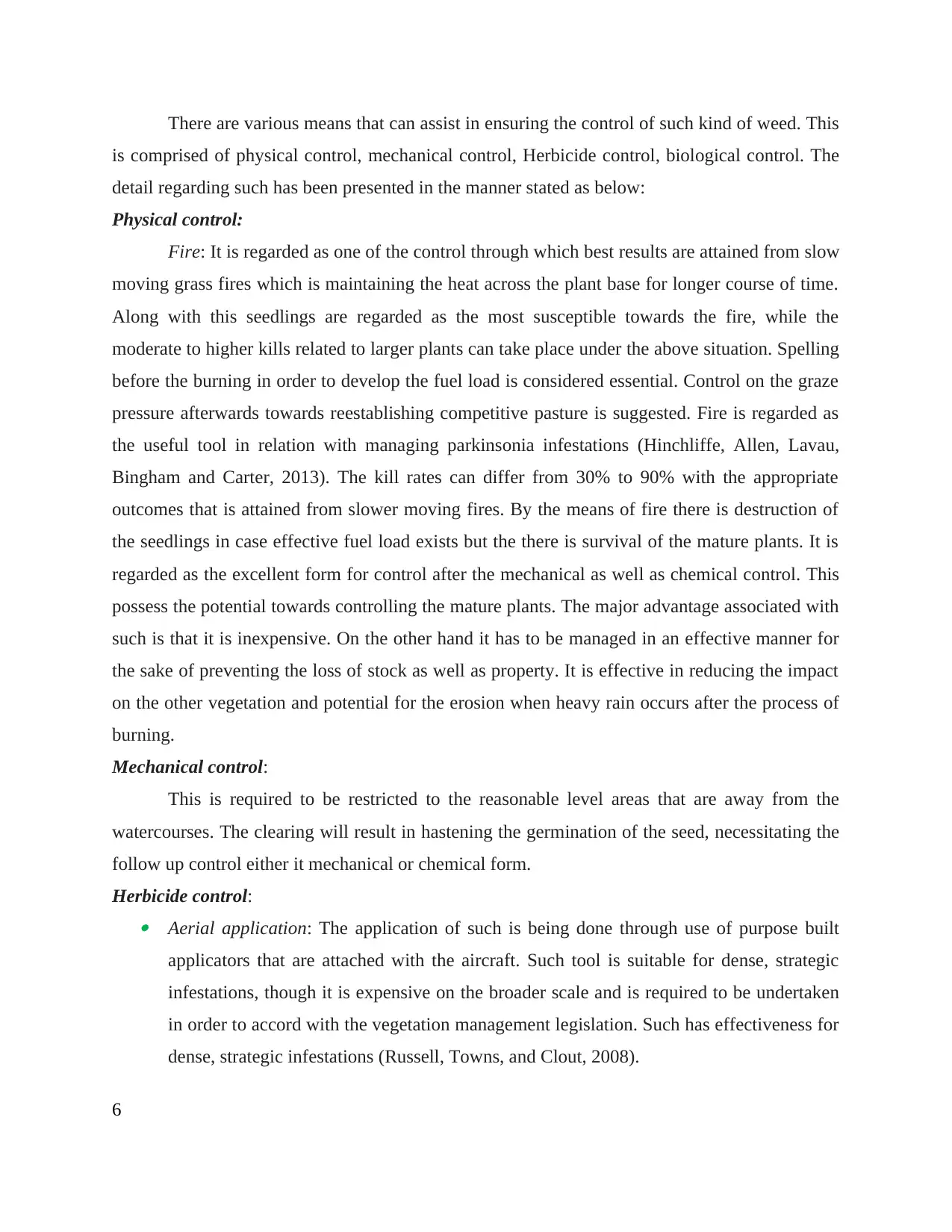
There are various means that can assist in ensuring the control of such kind of weed. This
is comprised of physical control, mechanical control, Herbicide control, biological control. The
detail regarding such has been presented in the manner stated as below:
Physical control:
Fire: It is regarded as one of the control through which best results are attained from slow
moving grass fires which is maintaining the heat across the plant base for longer course of time.
Along with this seedlings are regarded as the most susceptible towards the fire, while the
moderate to higher kills related to larger plants can take place under the above situation. Spelling
before the burning in order to develop the fuel load is considered essential. Control on the graze
pressure afterwards towards reestablishing competitive pasture is suggested. Fire is regarded as
the useful tool in relation with managing parkinsonia infestations (Hinchliffe, Allen, Lavau,
Bingham and Carter, 2013). The kill rates can differ from 30% to 90% with the appropriate
outcomes that is attained from slower moving fires. By the means of fire there is destruction of
the seedlings in case effective fuel load exists but the there is survival of the mature plants. It is
regarded as the excellent form for control after the mechanical as well as chemical control. This
possess the potential towards controlling the mature plants. The major advantage associated with
such is that it is inexpensive. On the other hand it has to be managed in an effective manner for
the sake of preventing the loss of stock as well as property. It is effective in reducing the impact
on the other vegetation and potential for the erosion when heavy rain occurs after the process of
burning.
Mechanical control:
This is required to be restricted to the reasonable level areas that are away from the
watercourses. The clearing will result in hastening the germination of the seed, necessitating the
follow up control either it mechanical or chemical form.
Herbicide control: Aerial application: The application of such is being done through use of purpose built
applicators that are attached with the aircraft. Such tool is suitable for dense, strategic
infestations, though it is expensive on the broader scale and is required to be undertaken
in order to accord with the vegetation management legislation. Such has effectiveness for
dense, strategic infestations (Russell, Towns, and Clout, 2008).
6
is comprised of physical control, mechanical control, Herbicide control, biological control. The
detail regarding such has been presented in the manner stated as below:
Physical control:
Fire: It is regarded as one of the control through which best results are attained from slow
moving grass fires which is maintaining the heat across the plant base for longer course of time.
Along with this seedlings are regarded as the most susceptible towards the fire, while the
moderate to higher kills related to larger plants can take place under the above situation. Spelling
before the burning in order to develop the fuel load is considered essential. Control on the graze
pressure afterwards towards reestablishing competitive pasture is suggested. Fire is regarded as
the useful tool in relation with managing parkinsonia infestations (Hinchliffe, Allen, Lavau,
Bingham and Carter, 2013). The kill rates can differ from 30% to 90% with the appropriate
outcomes that is attained from slower moving fires. By the means of fire there is destruction of
the seedlings in case effective fuel load exists but the there is survival of the mature plants. It is
regarded as the excellent form for control after the mechanical as well as chemical control. This
possess the potential towards controlling the mature plants. The major advantage associated with
such is that it is inexpensive. On the other hand it has to be managed in an effective manner for
the sake of preventing the loss of stock as well as property. It is effective in reducing the impact
on the other vegetation and potential for the erosion when heavy rain occurs after the process of
burning.
Mechanical control:
This is required to be restricted to the reasonable level areas that are away from the
watercourses. The clearing will result in hastening the germination of the seed, necessitating the
follow up control either it mechanical or chemical form.
Herbicide control: Aerial application: The application of such is being done through use of purpose built
applicators that are attached with the aircraft. Such tool is suitable for dense, strategic
infestations, though it is expensive on the broader scale and is required to be undertaken
in order to accord with the vegetation management legislation. Such has effectiveness for
dense, strategic infestations (Russell, Towns, and Clout, 2008).
6
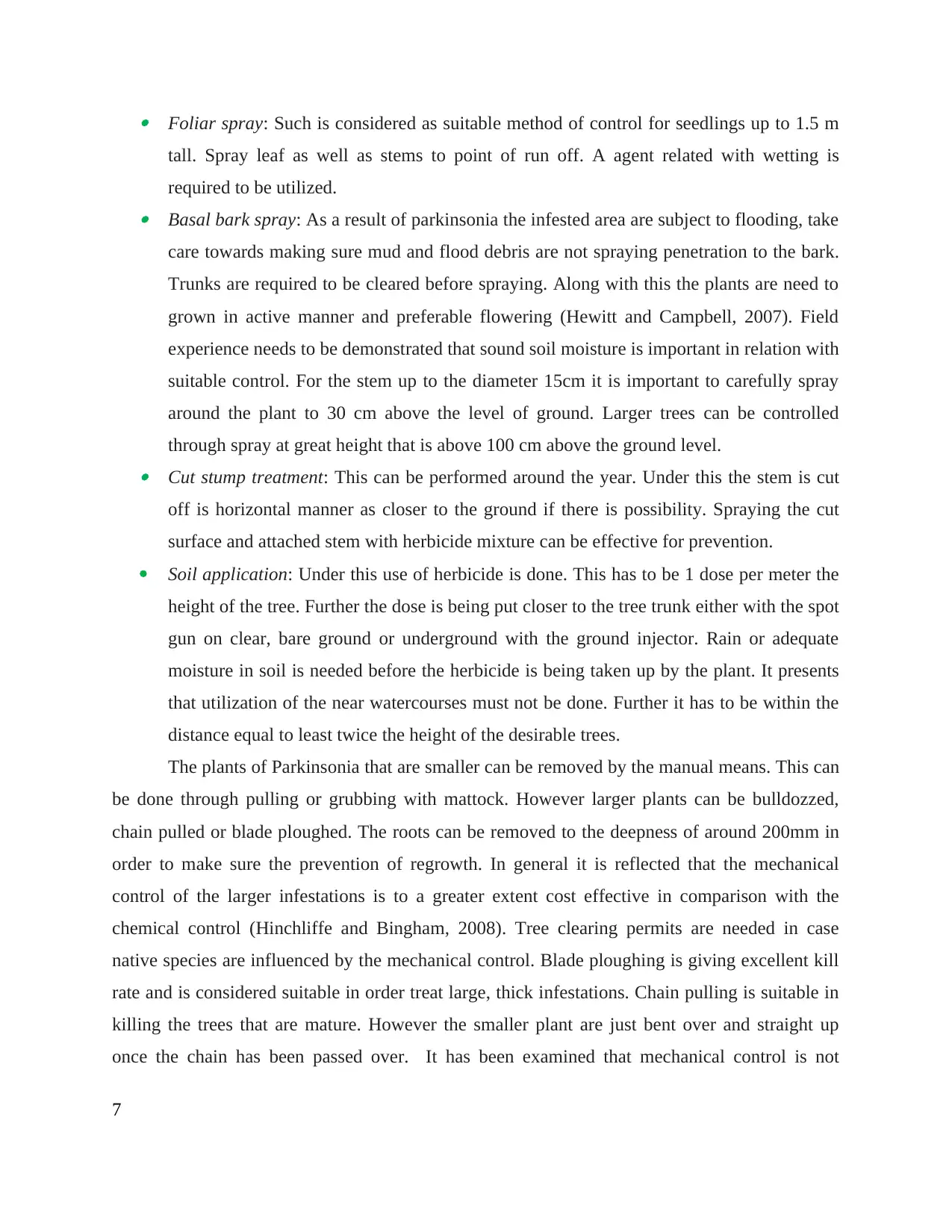
Foliar spray: Such is considered as suitable method of control for seedlings up to 1.5 m
tall. Spray leaf as well as stems to point of run off. A agent related with wetting is
required to be utilized. Basal bark spray: As a result of parkinsonia the infested area are subject to flooding, take
care towards making sure mud and flood debris are not spraying penetration to the bark.
Trunks are required to be cleared before spraying. Along with this the plants are need to
grown in active manner and preferable flowering (Hewitt and Campbell, 2007). Field
experience needs to be demonstrated that sound soil moisture is important in relation with
suitable control. For the stem up to the diameter 15cm it is important to carefully spray
around the plant to 30 cm above the level of ground. Larger trees can be controlled
through spray at great height that is above 100 cm above the ground level. Cut stump treatment: This can be performed around the year. Under this the stem is cut
off is horizontal manner as closer to the ground if there is possibility. Spraying the cut
surface and attached stem with herbicide mixture can be effective for prevention.
Soil application: Under this use of herbicide is done. This has to be 1 dose per meter the
height of the tree. Further the dose is being put closer to the tree trunk either with the spot
gun on clear, bare ground or underground with the ground injector. Rain or adequate
moisture in soil is needed before the herbicide is being taken up by the plant. It presents
that utilization of the near watercourses must not be done. Further it has to be within the
distance equal to least twice the height of the desirable trees.
The plants of Parkinsonia that are smaller can be removed by the manual means. This can
be done through pulling or grubbing with mattock. However larger plants can be bulldozzed,
chain pulled or blade ploughed. The roots can be removed to the deepness of around 200mm in
order to make sure the prevention of regrowth. In general it is reflected that the mechanical
control of the larger infestations is to a greater extent cost effective in comparison with the
chemical control (Hinchliffe and Bingham, 2008). Tree clearing permits are needed in case
native species are influenced by the mechanical control. Blade ploughing is giving excellent kill
rate and is considered suitable in order treat large, thick infestations. Chain pulling is suitable in
killing the trees that are mature. However the smaller plant are just bent over and straight up
once the chain has been passed over. It has been examined that mechanical control is not
7
tall. Spray leaf as well as stems to point of run off. A agent related with wetting is
required to be utilized. Basal bark spray: As a result of parkinsonia the infested area are subject to flooding, take
care towards making sure mud and flood debris are not spraying penetration to the bark.
Trunks are required to be cleared before spraying. Along with this the plants are need to
grown in active manner and preferable flowering (Hewitt and Campbell, 2007). Field
experience needs to be demonstrated that sound soil moisture is important in relation with
suitable control. For the stem up to the diameter 15cm it is important to carefully spray
around the plant to 30 cm above the level of ground. Larger trees can be controlled
through spray at great height that is above 100 cm above the ground level. Cut stump treatment: This can be performed around the year. Under this the stem is cut
off is horizontal manner as closer to the ground if there is possibility. Spraying the cut
surface and attached stem with herbicide mixture can be effective for prevention.
Soil application: Under this use of herbicide is done. This has to be 1 dose per meter the
height of the tree. Further the dose is being put closer to the tree trunk either with the spot
gun on clear, bare ground or underground with the ground injector. Rain or adequate
moisture in soil is needed before the herbicide is being taken up by the plant. It presents
that utilization of the near watercourses must not be done. Further it has to be within the
distance equal to least twice the height of the desirable trees.
The plants of Parkinsonia that are smaller can be removed by the manual means. This can
be done through pulling or grubbing with mattock. However larger plants can be bulldozzed,
chain pulled or blade ploughed. The roots can be removed to the deepness of around 200mm in
order to make sure the prevention of regrowth. In general it is reflected that the mechanical
control of the larger infestations is to a greater extent cost effective in comparison with the
chemical control (Hinchliffe and Bingham, 2008). Tree clearing permits are needed in case
native species are influenced by the mechanical control. Blade ploughing is giving excellent kill
rate and is considered suitable in order treat large, thick infestations. Chain pulling is suitable in
killing the trees that are mature. However the smaller plant are just bent over and straight up
once the chain has been passed over. It has been examined that mechanical control is not
7
Secure Best Marks with AI Grader
Need help grading? Try our AI Grader for instant feedback on your assignments.
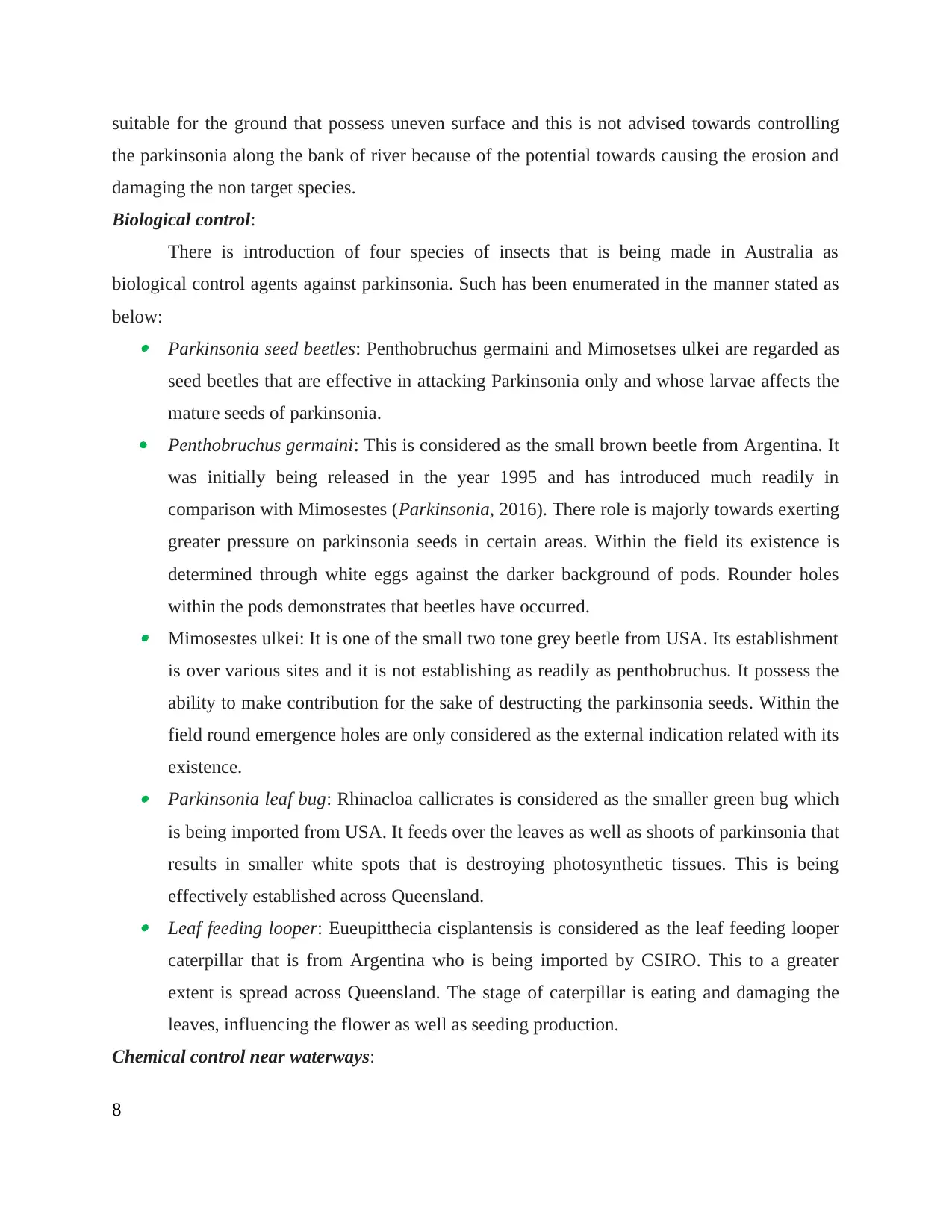
suitable for the ground that possess uneven surface and this is not advised towards controlling
the parkinsonia along the bank of river because of the potential towards causing the erosion and
damaging the non target species.
Biological control:
There is introduction of four species of insects that is being made in Australia as
biological control agents against parkinsonia. Such has been enumerated in the manner stated as
below: Parkinsonia seed beetles: Penthobruchus germaini and Mimosetses ulkei are regarded as
seed beetles that are effective in attacking Parkinsonia only and whose larvae affects the
mature seeds of parkinsonia.
Penthobruchus germaini: This is considered as the small brown beetle from Argentina. It
was initially being released in the year 1995 and has introduced much readily in
comparison with Mimosestes (Parkinsonia, 2016). There role is majorly towards exerting
greater pressure on parkinsonia seeds in certain areas. Within the field its existence is
determined through white eggs against the darker background of pods. Rounder holes
within the pods demonstrates that beetles have occurred. Mimosestes ulkei: It is one of the small two tone grey beetle from USA. Its establishment
is over various sites and it is not establishing as readily as penthobruchus. It possess the
ability to make contribution for the sake of destructing the parkinsonia seeds. Within the
field round emergence holes are only considered as the external indication related with its
existence. Parkinsonia leaf bug: Rhinacloa callicrates is considered as the smaller green bug which
is being imported from USA. It feeds over the leaves as well as shoots of parkinsonia that
results in smaller white spots that is destroying photosynthetic tissues. This is being
effectively established across Queensland. Leaf feeding looper: Eueupitthecia cisplantensis is considered as the leaf feeding looper
caterpillar that is from Argentina who is being imported by CSIRO. This to a greater
extent is spread across Queensland. The stage of caterpillar is eating and damaging the
leaves, influencing the flower as well as seeding production.
Chemical control near waterways:
8
the parkinsonia along the bank of river because of the potential towards causing the erosion and
damaging the non target species.
Biological control:
There is introduction of four species of insects that is being made in Australia as
biological control agents against parkinsonia. Such has been enumerated in the manner stated as
below: Parkinsonia seed beetles: Penthobruchus germaini and Mimosetses ulkei are regarded as
seed beetles that are effective in attacking Parkinsonia only and whose larvae affects the
mature seeds of parkinsonia.
Penthobruchus germaini: This is considered as the small brown beetle from Argentina. It
was initially being released in the year 1995 and has introduced much readily in
comparison with Mimosestes (Parkinsonia, 2016). There role is majorly towards exerting
greater pressure on parkinsonia seeds in certain areas. Within the field its existence is
determined through white eggs against the darker background of pods. Rounder holes
within the pods demonstrates that beetles have occurred. Mimosestes ulkei: It is one of the small two tone grey beetle from USA. Its establishment
is over various sites and it is not establishing as readily as penthobruchus. It possess the
ability to make contribution for the sake of destructing the parkinsonia seeds. Within the
field round emergence holes are only considered as the external indication related with its
existence. Parkinsonia leaf bug: Rhinacloa callicrates is considered as the smaller green bug which
is being imported from USA. It feeds over the leaves as well as shoots of parkinsonia that
results in smaller white spots that is destroying photosynthetic tissues. This is being
effectively established across Queensland. Leaf feeding looper: Eueupitthecia cisplantensis is considered as the leaf feeding looper
caterpillar that is from Argentina who is being imported by CSIRO. This to a greater
extent is spread across Queensland. The stage of caterpillar is eating and damaging the
leaves, influencing the flower as well as seeding production.
Chemical control near waterways:
8
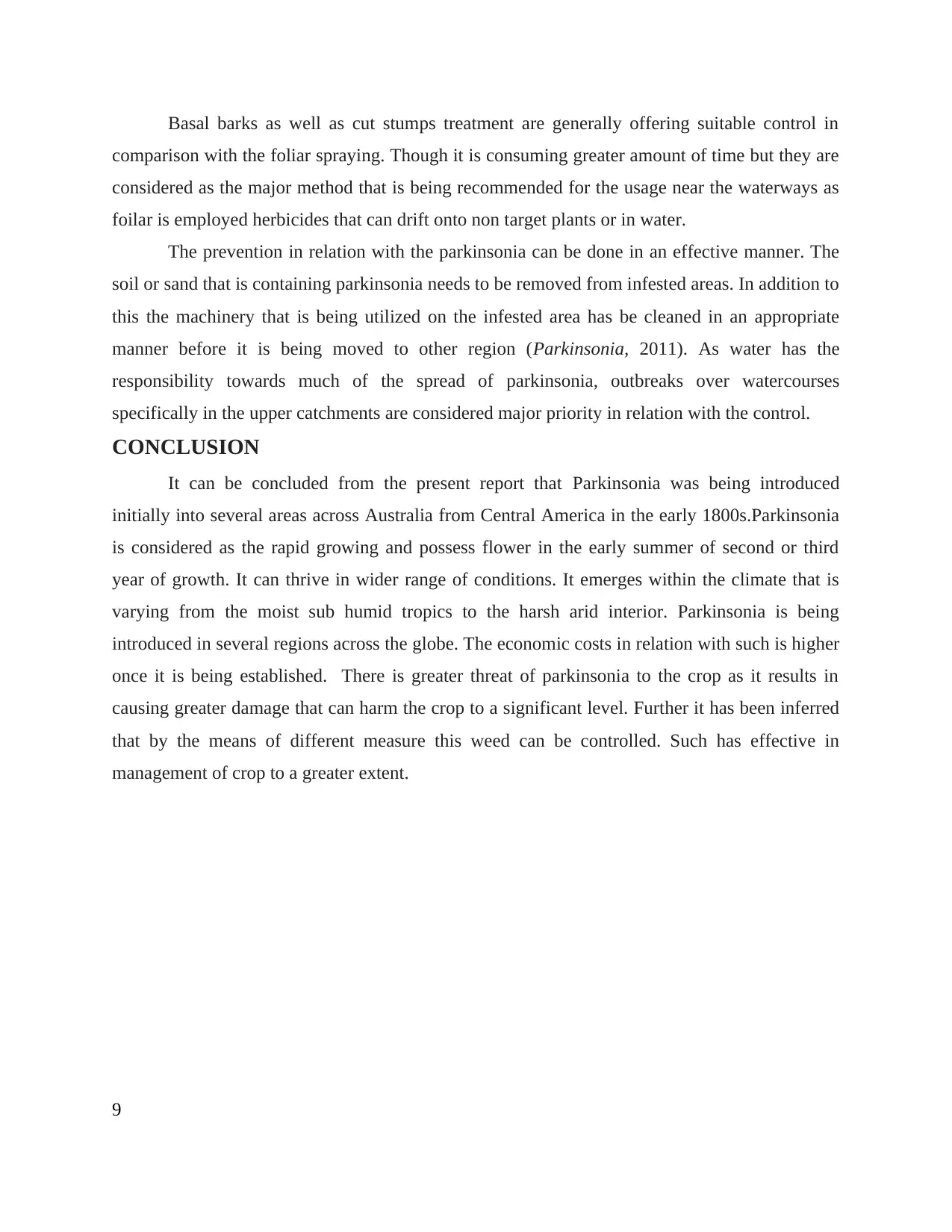
Basal barks as well as cut stumps treatment are generally offering suitable control in
comparison with the foliar spraying. Though it is consuming greater amount of time but they are
considered as the major method that is being recommended for the usage near the waterways as
foilar is employed herbicides that can drift onto non target plants or in water.
The prevention in relation with the parkinsonia can be done in an effective manner. The
soil or sand that is containing parkinsonia needs to be removed from infested areas. In addition to
this the machinery that is being utilized on the infested area has be cleaned in an appropriate
manner before it is being moved to other region (Parkinsonia, 2011). As water has the
responsibility towards much of the spread of parkinsonia, outbreaks over watercourses
specifically in the upper catchments are considered major priority in relation with the control.
CONCLUSION
It can be concluded from the present report that Parkinsonia was being introduced
initially into several areas across Australia from Central America in the early 1800s.Parkinsonia
is considered as the rapid growing and possess flower in the early summer of second or third
year of growth. It can thrive in wider range of conditions. It emerges within the climate that is
varying from the moist sub humid tropics to the harsh arid interior. Parkinsonia is being
introduced in several regions across the globe. The economic costs in relation with such is higher
once it is being established. There is greater threat of parkinsonia to the crop as it results in
causing greater damage that can harm the crop to a significant level. Further it has been inferred
that by the means of different measure this weed can be controlled. Such has effective in
management of crop to a greater extent.
9
comparison with the foliar spraying. Though it is consuming greater amount of time but they are
considered as the major method that is being recommended for the usage near the waterways as
foilar is employed herbicides that can drift onto non target plants or in water.
The prevention in relation with the parkinsonia can be done in an effective manner. The
soil or sand that is containing parkinsonia needs to be removed from infested areas. In addition to
this the machinery that is being utilized on the infested area has be cleaned in an appropriate
manner before it is being moved to other region (Parkinsonia, 2011). As water has the
responsibility towards much of the spread of parkinsonia, outbreaks over watercourses
specifically in the upper catchments are considered major priority in relation with the control.
CONCLUSION
It can be concluded from the present report that Parkinsonia was being introduced
initially into several areas across Australia from Central America in the early 1800s.Parkinsonia
is considered as the rapid growing and possess flower in the early summer of second or third
year of growth. It can thrive in wider range of conditions. It emerges within the climate that is
varying from the moist sub humid tropics to the harsh arid interior. Parkinsonia is being
introduced in several regions across the globe. The economic costs in relation with such is higher
once it is being established. There is greater threat of parkinsonia to the crop as it results in
causing greater damage that can harm the crop to a significant level. Further it has been inferred
that by the means of different measure this weed can be controlled. Such has effective in
management of crop to a greater extent.
9
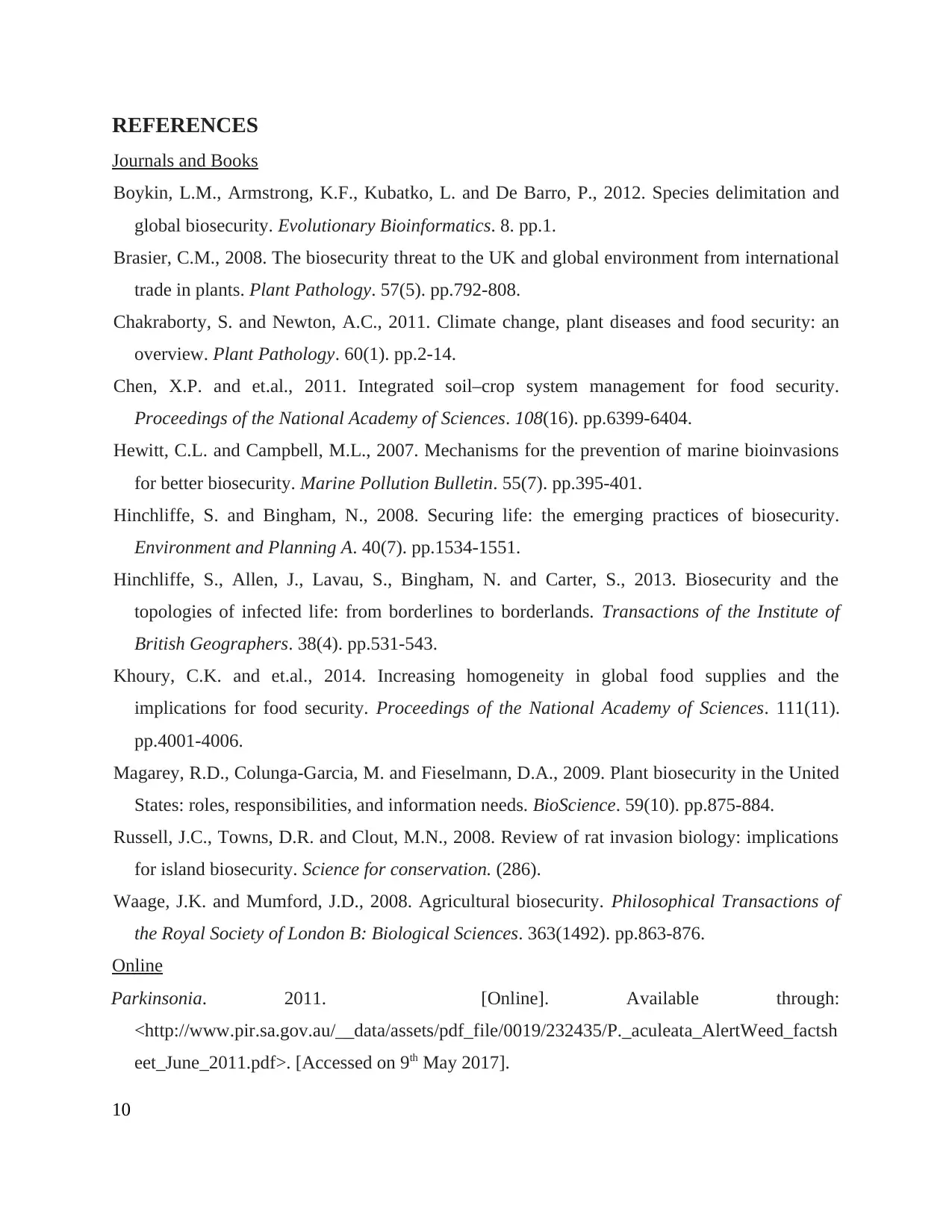
REFERENCES
Journals and Books
Boykin, L.M., Armstrong, K.F., Kubatko, L. and De Barro, P., 2012. Species delimitation and
global biosecurity. Evolutionary Bioinformatics. 8. pp.1.
Brasier, C.M., 2008. The biosecurity threat to the UK and global environment from international
trade in plants. Plant Pathology. 57(5). pp.792-808.
Chakraborty, S. and Newton, A.C., 2011. Climate change, plant diseases and food security: an
overview. Plant Pathology. 60(1). pp.2-14.
Chen, X.P. and et.al., 2011. Integrated soil–crop system management for food security.
Proceedings of the National Academy of Sciences. 108(16). pp.6399-6404.
Hewitt, C.L. and Campbell, M.L., 2007. Mechanisms for the prevention of marine bioinvasions
for better biosecurity. Marine Pollution Bulletin. 55(7). pp.395-401.
Hinchliffe, S. and Bingham, N., 2008. Securing life: the emerging practices of biosecurity.
Environment and Planning A. 40(7). pp.1534-1551.
Hinchliffe, S., Allen, J., Lavau, S., Bingham, N. and Carter, S., 2013. Biosecurity and the
topologies of infected life: from borderlines to borderlands. Transactions of the Institute of
British Geographers. 38(4). pp.531-543.
Khoury, C.K. and et.al., 2014. Increasing homogeneity in global food supplies and the
implications for food security. Proceedings of the National Academy of Sciences. 111(11).
pp.4001-4006.
Magarey, R.D., Colunga-Garcia, M. and Fieselmann, D.A., 2009. Plant biosecurity in the United
States: roles, responsibilities, and information needs. BioScience. 59(10). pp.875-884.
Russell, J.C., Towns, D.R. and Clout, M.N., 2008. Review of rat invasion biology: implications
for island biosecurity. Science for conservation. (286).
Waage, J.K. and Mumford, J.D., 2008. Agricultural biosecurity. Philosophical Transactions of
the Royal Society of London B: Biological Sciences. 363(1492). pp.863-876.
Online
Parkinsonia. 2011. [Online]. Available through:
<http://www.pir.sa.gov.au/__data/assets/pdf_file/0019/232435/P._aculeata_AlertWeed_factsh
eet_June_2011.pdf>. [Accessed on 9th May 2017].
10
Journals and Books
Boykin, L.M., Armstrong, K.F., Kubatko, L. and De Barro, P., 2012. Species delimitation and
global biosecurity. Evolutionary Bioinformatics. 8. pp.1.
Brasier, C.M., 2008. The biosecurity threat to the UK and global environment from international
trade in plants. Plant Pathology. 57(5). pp.792-808.
Chakraborty, S. and Newton, A.C., 2011. Climate change, plant diseases and food security: an
overview. Plant Pathology. 60(1). pp.2-14.
Chen, X.P. and et.al., 2011. Integrated soil–crop system management for food security.
Proceedings of the National Academy of Sciences. 108(16). pp.6399-6404.
Hewitt, C.L. and Campbell, M.L., 2007. Mechanisms for the prevention of marine bioinvasions
for better biosecurity. Marine Pollution Bulletin. 55(7). pp.395-401.
Hinchliffe, S. and Bingham, N., 2008. Securing life: the emerging practices of biosecurity.
Environment and Planning A. 40(7). pp.1534-1551.
Hinchliffe, S., Allen, J., Lavau, S., Bingham, N. and Carter, S., 2013. Biosecurity and the
topologies of infected life: from borderlines to borderlands. Transactions of the Institute of
British Geographers. 38(4). pp.531-543.
Khoury, C.K. and et.al., 2014. Increasing homogeneity in global food supplies and the
implications for food security. Proceedings of the National Academy of Sciences. 111(11).
pp.4001-4006.
Magarey, R.D., Colunga-Garcia, M. and Fieselmann, D.A., 2009. Plant biosecurity in the United
States: roles, responsibilities, and information needs. BioScience. 59(10). pp.875-884.
Russell, J.C., Towns, D.R. and Clout, M.N., 2008. Review of rat invasion biology: implications
for island biosecurity. Science for conservation. (286).
Waage, J.K. and Mumford, J.D., 2008. Agricultural biosecurity. Philosophical Transactions of
the Royal Society of London B: Biological Sciences. 363(1492). pp.863-876.
Online
Parkinsonia. 2011. [Online]. Available through:
<http://www.pir.sa.gov.au/__data/assets/pdf_file/0019/232435/P._aculeata_AlertWeed_factsh
eet_June_2011.pdf>. [Accessed on 9th May 2017].
10
Paraphrase This Document
Need a fresh take? Get an instant paraphrase of this document with our AI Paraphraser

Parkinsonia. 2016. [Online]. Available through:
<https://www.environment.gov.au/biodiversity/invasive/weeds/publications/guidelines/
wons/pubs/p-aculeata.pdf>. [Accessed on 9th May 2017].
11
<https://www.environment.gov.au/biodiversity/invasive/weeds/publications/guidelines/
wons/pubs/p-aculeata.pdf>. [Accessed on 9th May 2017].
11
1 out of 11
![[object Object]](/_next/static/media/star-bottom.7253800d.svg)